| A Quick Guide to Wood Finishes |
 |
| When it comes to Wood Finishes, it can seem overwhelming. With the endless options and all their differing results, it can get a bit confusing. However this article will break it down into a quick and simple guide. That way you will know exactly what you will need and when to use it. The wood finishes we will be discussing in this article are Stain/Dyes, Oil, Wax, Shellac, Varnish, Lacquer, and Polyurethane.
|
| Wood Stains and Dyes |
 |
| Wood Stains/Dyes are designed to change the colour of the wood whilst still having the natural wood grain be visible. There are many colour options available however the outcome you will receive after application does depend on the type of wood being used. It is important to always test your stain/dye on a scrap piece of wood first in order to determine the colouring. If the colour is too intense, the stain/dye can be diluted with mineral spirits, alternatively if the colour is too dull then you can apply multiple layers.
When applying the stain/dye, use a cloth or a paint brush. Depending on the type of wood you are using, you may need to lightly sand in between layers as sometimes the stain/dye can raise the grain of the wood. Once applied, the stain/dye will dry fast however a protective finish, such as varnish, will need to be applied on top as wood stains/dyes don't provide protection. Wood stain/dye is recommended to be used on furniture, both indoor (shelves, chairs etc.) or outdoor (decks, fences, etc.).
|
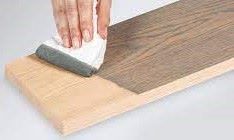
Wood Stain
|
| Oil |
 |
| Oil brings out the natural beauty of the wood by making the grain pop and bringing back the wood's natural warm colouring. It does this by nourishing the wood. There are five popular types of wood oil, Boiled Linseed Oil, Teak Oil, Mineral Oil, Tung Oil, and Danish Oil. Out of all these types, Boiled Linseed Oil and Tung Oil are highly recommended penetrative finishes, however the intent of their purpose will affect your decision. A penetrative finish means that the oil penetrates the wood fibers and hardens.
Both Boiled Linseed Oil and Tung Oil are inexpensive, easy to apply, and available in multiple forms. Tung Oil in particular is available in pure unrefined or heat treated versions. If you were looking for a food safe Oil for something such as a cutting board, then Mineral Oil would be the choice for you. The Oil that offers the most protection would be Danish Oil as it is a mix between oil and varnish. Overall, each wood oil provides little protection against moisture. As well, a wood oil should be applied with a brush or cloth and multiple coats can be applied to build up. Wood Oil is best for wood furniture, outdoor decking, or dishware (only mineral oil is food safe).
|
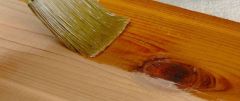
Wood Oil
|
| Wax |
 |
| Wax is made from beeswax and is available in clear and coloured formulas. Similarly, Wax also brings out the natural beauty of the wood however not to the same extent as an Oil. When applying, sparingly apply with a cloth or paint brush in circular motions. After a few hours the Wax will dry to a smooth matte finish, however for a satin sheen, buff out the wax with a cloth.
Since Wax offers minimal protection, it is best used for internal items such as a tabletop. An important note about Wax is that it must always be applied last, meaning it can be applied on its own or on top of other finishes however no other finishes can be applied on top of the Wax. Luckily though, Wax can be reapplied once every year or two to keep up appearance and protection. Wax is best used for projects looking for a hand painted appearance.
|
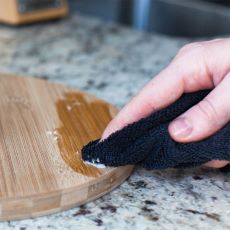
Wood Wax
|
| Shellac |
 |
|
Shellac is a waxy resin that is mixed with alcohol solvents. This finish is easy to apply and dries quickly to a glossy finish. It is often used on antiques, however it dulls with age. Shellac is commonly used in french polishing which is a technique that uses lots of very thin coats. Shellac is best used on fine furniture or antiques.
|
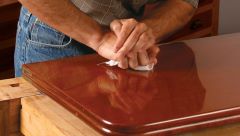
Wood Shellac
|
| Varnish |
 |
|
Varnish is a mixture of oil, resin, and solvents. This finish dries very slowly but is great for exterior use such as garden furniture. In comparison to Polyurethane; Varnish is cheaper, has better UV protection but lacks durability. As well, the type of resin used in the varnish does determine the characteristics of the finish. Since varnish protects against scratches or abrasions, it is best recommended for cabinets, floorboards, furniture, or walls.
|
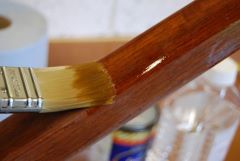
Wood Varnish
|
| Lacquer |
 |
|
Lacquer is a thin liquid varnish that is usually applied as a spray. It dries quickly as the solvents evaporate and can be polished to a glossy finish. Lacquer is said to be the best of all finishes as it brings out the wood's natural beauty without drastically changing the colour as well as creates a durable, hard wearing surface. There are three types of Lacquers; Nitrocellulose, Acrylic, and Catalyzed. Nitrocellulose is the most common however it yellows over time. Whereas the Acrylic won't ever yellow over time. Lacquer is best used on high end furniture as it creates a modern wood finish.
|
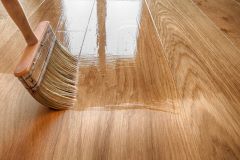
Wood Lacquer
|
| Polyurethane |
 |
|
Polyurethane is simply put, a liquid plastic coating for wood that comes in both water based or oil based formulas. Water based dries faster however it doesn't quite bring out the wood's natural beauty whereas oil based dries slower yet brings out the natural warmth of the wood. Polyurethane is available in three different types of finishes; matte, gloss, or sheen. Out of all the listed above finishes, Polyurethane is the most durable and hardwearing. This makes it a great choice for floorboards.
|
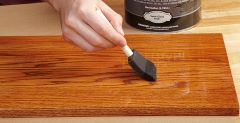
Wood Polyurethane
|
| Additional Resources |
 |
|
There are many options when it comes to wood finishes; Wood Stain/Dye, Oil, Wax, Shellac, Varnish, Lacquer, or Polyurethane. However we hope this brief guide was able to help you understand each finish better and make a thoughtful decision for your next project! Whether you're just looking to bring out the natural beauty of the wood, or provide the most durable protective layer. At least one of these finishes should be able to provide exactly what you need.
For more information on brushes, click here!
For more information on how to finish your picture frames, click here!
To learn more about our art supplies, click here!
|

KeenART Media
|
|
If you have questions about any of our services or products, don't hesitate to contact us. Our knowledgeable staff is always happy to assist with answers, advice, or suggestions.
|
|

|



|
USA Giclee On Canvas, Fine Art Printing - Art Scanning & Reproductions - Handmade Oil Paintings - Custom Wood Panels, Metal Picture Framing - Block/Plaque Mountings, Large Format Dry Mounting & Lamination - Art Supplies: Stretcher Bars, Cradled Wood Panels and Artist Canvas - Collages On Canvas - Plexi/Acrylic Face Mounts - Block Acrylics, Fabric Printing, Dye Sublimation - Cityscape Skyline Prints, Resin, Photo Gifts and more...
|
|
© 2002-2025 - KeenART Media Ltd.
|
|
| |
|
